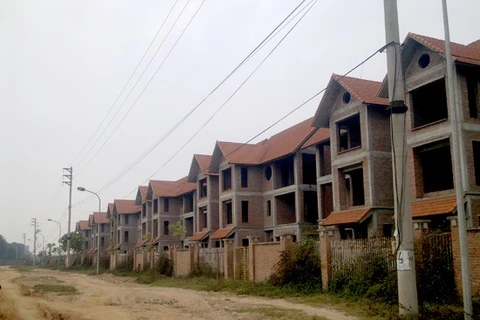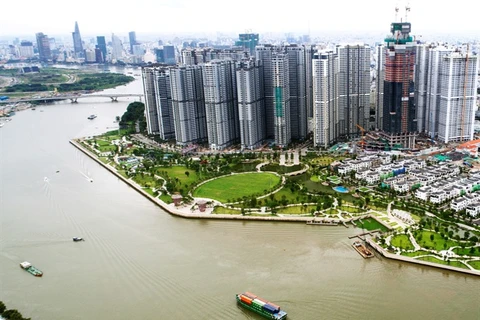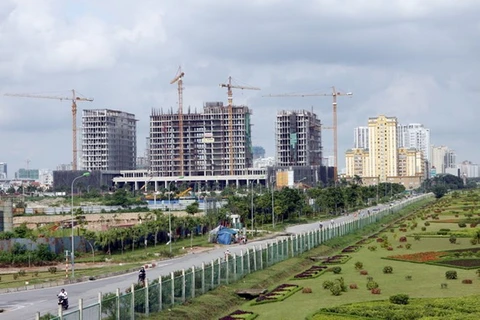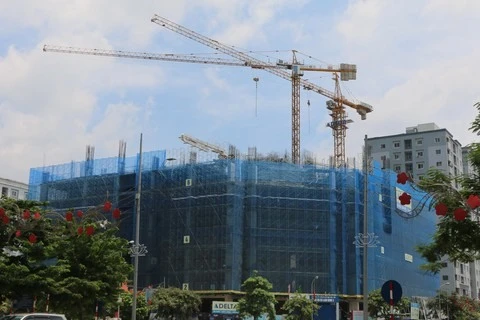 Vietnam witnessed positive development in the real estate market in 2017 with increased transactions of apartments and reduction in real estate inventory. (Source:realtimes.vn)
Vietnam witnessed positive development in the real estate market in 2017 with increased transactions of apartments and reduction in real estate inventory. (Source:realtimes.vn) Hanoi (VNS/VNA) – Vietnam witnessed positive development in the real estate market in 2017 with increased transactions of apartments and reduction in real estate inventory.
According to the National Financial Supervision Commission’s report on financial markets in 2017, the market did not see much change in property prices last year.
Prices mainly increased in the segments of high- and mid-end apartments. Prices rose by 3-10 percent for some high-end apartment projects in the urban area having convenient location, synchronous infrastructure, construction as per schedule and reputable investors, as well as attractive sales and promotional policies.
The price of high-end apartments increased at the fastest rate of 7-10 percent, while it rose 5-7 percent for mid-end apartments and 3-5 percent for affordable apartments.
In the domestic market in 2017, trading volume increased significantly compared with 2016, the report noted. The high- and mid-end apartment segments witnessed the highest trading volume. The number of successful transactions was estimated to reach 68,000 units.
Meanwhile, the report said real estate inventory of Vietnam was some 25.7 trillion VND, a reduction of 17 percent compared with December 2016. Hanoi and HCM City continued to be the cities with the largest real estate inventories, accounting for 40 percent of the country’s total inventory.
In 2017, the credit flowing into real estate trading and construction activities decreased slightly, accounting for 15.8 percent of total credit.
The end of 2017 marked a positive development in Hanoi’s condominium market, according to CBRE Vietnam’s quarterly report on Hanoi property market, released on January 4 in Hanoi.
In the last quarter, the market welcomed a record 9,500 new units, bringing 2017’s total fresh supply to 35,000 units, a year-on-year increase of 16 percent. This was also the highest number of new apartments entering the market in a year since the past five years. Fresh supply was spread across all districts in the city.
The market saw improved infrastructure and expansion of the out-of-centre area, while two new apartment projects were launched in Dong Anh district for the first time. The mid-end and affordable segments continued to dominate the market with a total 80 percent of the new supply in 2017.
The Hanoi property market had more than 23,000 successful transactions in 2017, a year-on-year surge of 12 percent.
Some projects were not located in favourable positions but still achieved good business results because of reasonable investment for the development of products and improved design of these products, along with providing convenient services for residents.
This showed that buyers paid more attention to quality property products, and, therefore, there was higher demand, CBRE Vietnam said.
In 2017, primary prices in the market increased slightly because of the high supply of new apartments and change in demand in the affordable segment, it said. Average selling price from developers stood at US$1,344 per sq.m, a year-on-year reduction of 2.4 percent.
CBRE Vietnam said in the future, positive development of the macro economy would continue to support the property market in general and the condominium market in particular.
With the development of the market and future supply in almost all areas of the city, the developers of apartment products will be under pressure to professionalise the sales team and perfect marketing activities for higher competitive ability and revenue, it said.
2018 is expected to see a sharp difference in development among segments, with high-end projects being developed in near-urban locations, while developers in the lower segments will improve their products further to deal with competitive pressure.-VNA
VNA

























